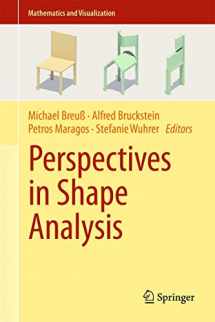
Perspectives in Shape Analysis (Mathematics and Visualization)
ISBN-13:
9783319247243
ISBN-10:
3319247247
Edition:
1st ed. 2016
Author:
Michael Breuß, Alfred Bruckstein, Petros Maragos, Stefanie Wuhrer
Publication date:
2016
Publisher:
Springer
Format:
Hardcover
387 pages
FREE US shipping
Book details
ISBN-13:
9783319247243
ISBN-10:
3319247247
Edition:
1st ed. 2016
Author:
Michael Breuß, Alfred Bruckstein, Petros Maragos, Stefanie Wuhrer
Publication date:
2016
Publisher:
Springer
Format:
Hardcover
387 pages
Summary
Perspectives in Shape Analysis (Mathematics and Visualization) (ISBN-13: 9783319247243 and ISBN-10: 3319247247), written by authors
Michael Breuß, Alfred Bruckstein, Petros Maragos, Stefanie Wuhrer, was published by Springer in 2016.
With an overall rating of 4.2 stars, it's a notable title among other
books. You can easily purchase or rent Perspectives in Shape Analysis (Mathematics and Visualization) (Hardcover) from BooksRun,
along with many other new and used
books
and textbooks.
And, if you're looking to sell your copy, our current buyback offer is $0.3.
Description
This book presents recent advances in the field of shape analysis. Written by experts in the fields of continuous-scale shape analysis, discrete shape analysis and sparsity, and numerical computing who hail from different communities, it provides a unique view of the topic from a broad range of perspectives.Over the last decade, it has become increasingly affordable to digitize shape information at high resolution. Yet analyzing and processing this data remains challenging because of the large amount of data involved, and because modern applications such as human-computer interaction require real-time processing. Meeting these challenges requires interdisciplinary approaches that combine concepts from a variety of research areas, including numerical computing, differential geometry, deformable shape modeling, sparse data representation, and machine learning. On the algorithmic side, many shape analysis tasks are modeled using partial differential equations, which can be solved using tools from the field of numerical computing. The fields of differential geometry and deformable shape modeling have recently begun to influence shape analysis methods. Furthermore, tools from the field of sparse representations, which aim to describe input data using a compressible representation with respect to a set of carefully selected basic elements, have the potential to significantly reduce the amount of data that needs to be processed in shape analysis tasks. The related field of machine learning offers similar potential.The goal of the Dagstuhl Seminar on New Perspectives in Shape Analysis held in February 2014 was to address these challenges with the help of the latest tools related to geometric, algorithmic and numerical concepts and to bring together researchers at the forefront of shape analysis who can work together to identify open problems and novel solutions. The book resulting from this seminar will appeal to researchers in the field of shape analysis, image and vision, from those who want to become more familiar with the field, to experts interested in learning about the latest advances.


We would LOVE it if you could help us and other readers by reviewing the book
Book review

Congratulations! We have received your book review.
{user}
{createdAt}
by {truncated_author}


